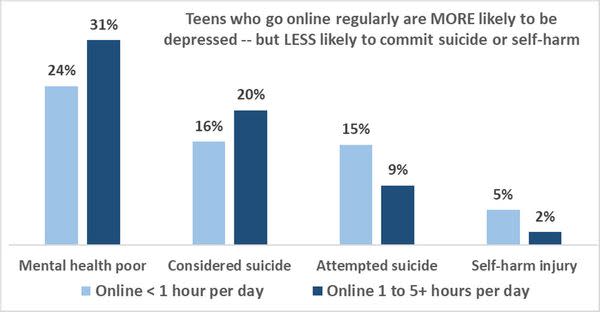Social media is a lifeline for mental health, not a curse, according to CDC's own data

The “sharp uptick in depression, anxiety, loneliness and suicide among young people is directly tied to the wide distribution of smartphones,” declares a typical press splash on psychologist Jonathan Haidt’s newly-released book. U.S. Surgeon General Vivek’ declares that Generation Z’s “mental health crisis” is “in part caused (by) their constant exposure to social media,” another reads amid a daily frenzy of panic condemning teens and screens.
In fact, top authorities barraging lawmakers and the public with a panicky, ill-founded crusade are distorting vital information and ignoring the real issues underlying teens’ mental health and how they use social media.
Let’s begin right at the source: the Centers for Disease Control’s massive, 116-question 2022 survey of 7,000 teenagers that defined and documented the teenage “mental health crisis” – the one almost everyone cites (or, rather, miscites). The full survey is readily downloadable for analysis. Yet, none of the relentlessly alarmist authorities, including Haidt and Murtha, appear to have done so – and, as a result, they may be endangering teens even more.
The one CDC finding the alarmists balloon into a larger campaign citing superficial, correlation-equals-causation “studies” is that teens who go online regularly (one to four hours a day) or frequently (five or more hours a day) report poorer mental health and more sadness than do teens who rarely or never go online (less than one hour a day) – with girls the most affected.
Unfortunately, these same professional and academic authorities omit or flatly falsify the important complexities the entire CDC survey and similarly reliable, comprehensive surveys and meta-analyses show. So what does the data really say about the link between social media and teen mental health?
Fact 1: Social media use is associated – overwhelmingly – with greater teenage safety

Analysis of the full CDC survey reveals a completely different picture, beginning with a fascinating paradox. Figure 1 shows that the same online teens who report being more depressed then go on to report fewer suicide attempts and many fewer hospitalizations for self-harm than do rarely-online teens.
That seemingly contradictory finding for social-media-using teens – more depression, less suicide – invites scrutiny by conscientious social scientists. The reason few did is suggested by the disturbing factor the CDC survey really associates with teen depression: violent (injurious) and psychological abuses by parents and household grownups, reported by an alarming 55% of teens, including 58% of teens under age 16, 63% of girls, and 74% of the LGBQ teens.
Three to four times more teens are bullied at home by grownups than are bullied online or at school. Teens bullied at home are many times more likely also to be bullied elsewhere – a reality authorities ignore.
Want more health and science stories in your inbox? Subscribe to Salon's weekly newsletter Lab Notes.
While teens who regularly or often go online are 41% less likely to attempt suicide and 62% less likely to be hospitalized for self-harm than rarely-online teens, teens regularly abused by parents/adults are nine times more likely to attempt suicide and 20 times more likely to suffer injuries from self-harm compared to non-abused teens.
So obsessed are the most publicized authorities with social media that they overlook far more important issues. Teens whose parents lost jobs during the pandemic are 34% more likely to suffer poor mental health, 55% more likely to suffer parental abuse, 55% more likely to attempt suicide and 140% more likely to self-harm compared to teens with employed parents. In families where parents lost jobs, twice as many girls as boys reported poor mental health and frequent abuses.
Standard mathematical regression analysis of the CDC survey shows parental abuses are associated with 13 times more teen depression than superficially blamed on social media. Even the most prominent social-media-blamers like psychology professors Jean Twenge and Haidt acknowledge \ the effect of social media on teens’ happiness is “small”, which large-scale meta-analyses also support.
Yet, authorities persist in insisting social media must be the big culprit. It’s as if researchers studying the causes of lung cancer arbitrarily decided to exclude the biggest factor — smoking tobacco — and instead crusaded against a superficial low-level correlation like listening to country music. After all,older rural white people suffer the highest lung cancer rates.
Fact 2: The virtual world is not more dangerous than the real world
The “virtual universe… is more dangerous in many respects … than the physical world,” Dr. Haidt declares. But the nirvana many authorities assume teen life would be if unsullied by screens is the diametric opposite of teens’ reality.
With startling consistency, the CDC survey shows that teens who are not online are the ones most at risk of suicide, self-harm, being raped, pharmaceutical abuse, other drug abuse (especially heroin), fighting, weapons carrying, unprotected sex, school and dating violence, getting fewer than seven hours of sleep a night and missing school due to fear. A few risks, like cigarette smoking, binge drinking and marijuana use are similar among teens regularly or frequently online as among non-online teens.
Fact 3: The most troubled teens are those who benefit most from social media
Teens who report being depressed, bullied by parents or LGBQ (what the CDC categorizes as lesbian, gay, bisexual, and/or questioning sexuality) are much less likely to attempt suicide, self-harm or other risks if they are online regularly or frequently compared to their counterparts who rarely/never go online.
LGBQ teens who are online are 45% less likely to attempt suicide, 54% less likely to suffer self-harm injury, 20% less likely to get fewer than seven hours of sleep a night and much less likely to be raped, binge-drink, abuse pills, try heroin, fear going to school, etc., compared to those rarely or never online. The greater online safety of teens abused by parents and household adults is similar.
Fact 4: Social media connects teens with others who help them
The table shows that nearly all the rarely-online teens who consider suicide actually go on to attempt suicide and one-third suffer self-harm, compared to fewer than half and 10%, respectively, of teens who go online regularly or frequently. Why are online teens of all ages and genders less likely to suffer serious outcomes than their non-online counterparts?
We don’t know exactly, but there are indications. The CDC and Pew Research surveys report teens (particularly younger, abused and depressed individuals) often go online to connect with people, such as “family, friends, or other groups” who “can support them through tough times,” as Pew noted. That’s one reason why more online hours is crudely associated with more teen depression – a classic case of “correlation does not mean causation.”
Fact 5: Over 700,000 parent-aged adults died from soaring overdoses and suicides from 2011 through 2021 as teen “depression” rose – also ignored by authorities
Have health authorities, condemning the much-publicized increases in suicides and drug overdose deaths by adolescents over the last decade, analyzed what actually drives those tragedies?
From 2011 to 2021, deaths from suicide and overdose rose from 2,337 to 3,532 for ages 16 to 19, and from 544 to 1,052 for ages 10 to 15. Suicides and drug overdose deaths among adults of parent ages (30 to 59) soared even more, from 49,676 in 2011 to 96,522 in 2021 – exactly the period teens were becoming more depressed. During the 2011-21 period, suicides and overdoses claimed a staggering 722,000 grownups ages 30 to 59 – roughly equivalent to the entire population of Denver disappearing.
Might that mass parent and adult self-destruction make teenagers more depressed? Compelling studies strongly implicate parents’ abusiveness, mental health and drug and alcohol problems for harming teens’ mental health and fostering suicide and other risks. While the CDC did ask about parents’ abuses and unemployment (both strongly connected to more teen depression, suicide attempts and self-harm), surveys haven’t asked about grownups’ drug/alcohol, mental health, sexual abuse and related issues.
Bizarrely, today’s authorities, led by the Surgeon General, seem completely uninterested in how these glaring parent and adult crises might affect teens. No, they insist the problem is low-association villains like TikTok, Facebook, Instagram and smartphones.
Fact 6: Teenage unhappiness relates to larger social conditions
Four times more liberal than conservative teens use social media to organize and activate, Pew Research finds. Girls, in particular, have dramatically brought down their crime, unplanned pregnancy and school dropout rates and are flooding universities and job sectors in record numbers. These are hardly signs of depression. Young liberals are also much more likely to be informed about global events such as climate change. What we term “depression” and “unhappiness” seem to motivate them to action.
Conservatives aware of these facts must be delighted at the help of liberal politicians in cutting off their young liberal base from social-media communications, information and expression. Gleeful conservatives, exploiting the official myth that teens who report being sad, depressed and anxious must be “mentally ill,” pronounce “children with liberal parents more likely to suffer mental health problems.”
A rough test of the claim that “conservatives are mentally healthier than liberals” is that during the period in question, 2011 to 2021, suicide rates among 10 to 19-year-olds rose 1.6 times faster to levels 1.3 times higher in Republican-controlled states than in Democrat-controlled states, a trend most affecting white teens. This is yet another indication that the “depression” teenagers report today is connected much less to suicide or mental illness than to larger social issues only now being assessed.
Current discussion tells us more about authorities’ mental state than teens’
Repeated panics over young people’s mental health have surfaced every few years over the past century, featuring condemnations of dime novels, nickelodeons, jazz, horror comics, reefer madness, drug lyrics, Hollywood this or that, rock’n’roll, rap, video games and now social media. Many authorities have always found it more satisfying to point accusing fingers at popular culture and cast themselves as heroic rescuers with cries of “the children!” than to confront distressing family and social conditions. Then, we wonder why the United States can’t seem to solve its globally disgraceful social and health epidemics.
Notable exceptions exist. In a 1936 speech to young people, President Franklin Roosevelt, dismissing experts proclaiming 1930s youth as “lost” to anxiety, depression and lassitude, declared that young people were right to be unhappy. Ridiculing the “two or three or four new panaceas in every day's papers” to cure young people, FDR welcomed the young “measuring the present state of the world out of your own experiences” and actively challenging its flaws.
Such dynamic affirmations are impossible to imagine today, in which the mental state of leading authorities is more obviously in question than that of young people. Far from being a “mental health problem,” young people’s unhappiness around the world may be the instigator of critically-needed social change.

